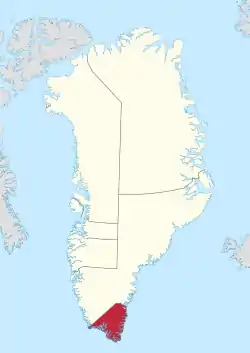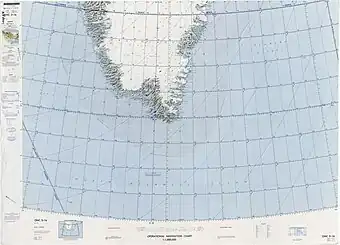Kujalleq
Kujalleq (Greenlandic: Greenlandic pronunciation: [kujaɬːɜq̚], Danish: Syden, lit. 'The South') is a municipality on the southern tip of Greenland, operational from 1 January 2009. The administrative center of the municipality is in Qaqortoq (formerly called Julianehåb).
Kujalleq
| |
|---|---|
| Kujalleq Municipality Kommune Kujalleq (Greenlandic) | |
 | |
 Flag  Coat of arms | |
 Location of Kujalleq within Greenland | |
| Coordinates (Kujalleq Commune): 61°00′N 45°00′W | |
| Sovereign state | |
| Country | |
| Municipality | Kujalleq |
| Established | 1 January 2009 |
| Municipal center | Qaqortoq |
| Government | |
| • Mayor | Kiista P. Isaksen (Siumut) |
| Area | |
| • Total | 32,000 km2 (12,355 sq mi) |
| Population (2022)[3] | |
| • Total | 6,292 |
| • Density | 0.197/km2 (0.51/sq mi) |
| Time zone | UTC-03 |
| Calling code | +299 |
| ISO 3166 code | GL-KU |
| Website | kujalleq.gl |
Creation
The municipality consists of the former municipalities of southern Greenland, each named after the biggest settlement:[1]
In addition to the area of these municipalities, uninhabited parts of the former municipalities of Paamiut and Ammassalik were added to the new administrative entity. In the case of Paamiut Municipality, it was exclusively a part of the ice sheet including a few nunataks, while in the case of Ammassalik Municipality, it included the coast from the fjord Kangerlussuatsiaq (in Danish Lindenow Fjord) on the old border with Nanortalik Municipality in the south to north of Timmiarmiut.
Coat of arms
The coat of arms of the municipality depicts a ram's head,[4] symbolising the sheep farming in the area, which has become one of the most important parts of Kujalleq's economy. The uppermost part of the shield contains the sun of the Greenlandic flag. Likewise the choice of colours matches those of the country's flag. The coat of arms was adopted in August 2008.
Geography

At 32,000 km2 (12,355.3 sq mi) of area Kujalleq is the smallest municipality in Greenland by area. Straddling the southernmost end of the island of Greenland, it is bordered by only one municipality, Sermersooq, in the north. The waters of the western coast are that of Labrador Sea, which meet the open North Atlantic at Uummannarsuaq, the southern cape. The border on the western coast runs alongside Alanngorsuaq Fjord and on the eastern coast up to Anorituup Kangerlua (Anoritoq) Fjord.
The entire municipal area is highly mountainous, with numerous fjords carving deeply into the land. All settlements are located on the western coast, or in fjords ending there.
Politics
Kujalleq's municipal council consists of 15 members, elected every four years.[5]
Administrative divisions
Nanortalik area
- Nanortalik (Nennortalik)
- Aappilattoq
- Alluitsup Paa (Sydprøven)
- Ammassivik (Sletten)
- Narsaq Kujalleq (Narsaq Kujalleq, Frederiksdal)
- Tasiusaq
- Qorlortorsuaq
Narsaq area
- Narsaq (Nordprøven)
- Igaliku (Igaliko)
- Narsarsuaq
- Qassiarsuk
Qaqortoq area
- Qaqortoq (Julianehåb)
- Eqalugaarsuit
- Qassimiut
- Saarloq
- Upernaviarsuk
Transportation

The only airport is Narsarsuaq Airport. Helicopters and boats go to other settlements.
See also
- KANUKOKA, the Greenlandic municipal association
- Eastern Settlement, the former Norse settlement in the area
- Lichtenfels & Lichtenau, former Moravian missions in the area
- Narsaq massacre
References
- "Kommune Kujalleq". Kujalleq Municipality. Archived from the original on 7 January 2013. Retrieved 11 July 2010.
- Statistics Greenland, Greenland in Figures 2010
- "Population January 1st by municipality and time". Statistical Greenland. Retrieved 12 March 2022.
- "Kujalleq - Civic heraldry of Greenland". HeraldryWeb. Retrieved May 9, 2011.
- Kujalleq.gl "Kommunalbestyrelsen"
- "Venskabsbyer: Aarhus Kommune". Aarhus.dk. Archived from the original on 2013-10-17. Retrieved 2013-03-25.